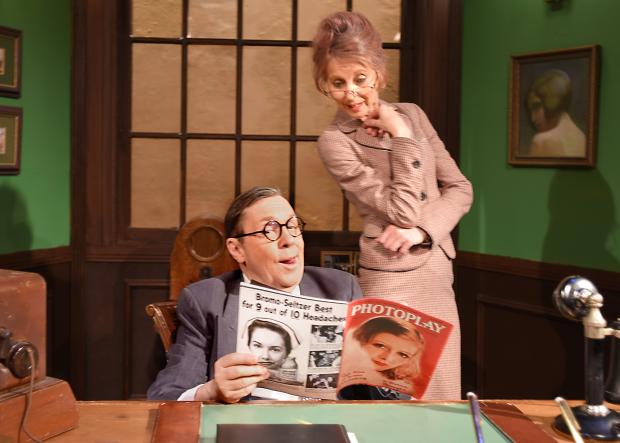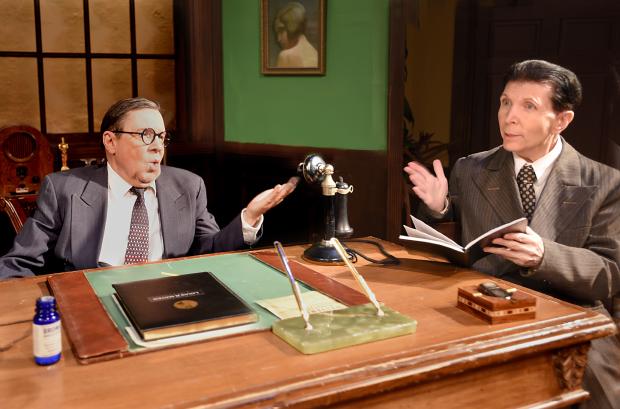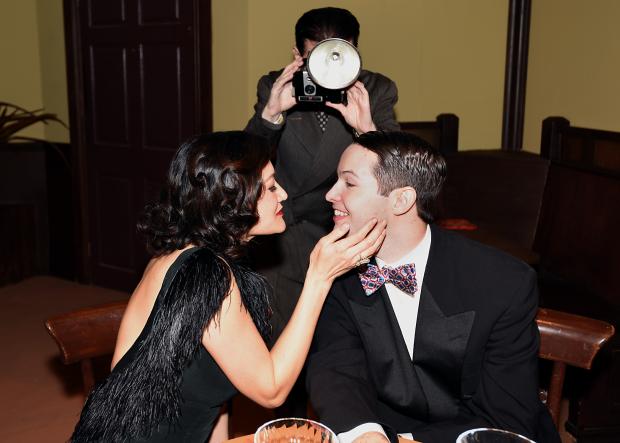By trade, I’m a full-time film historian/critic who has authored/co-authored four movie history books. I say this because at one point in the new play Taming the Lion Joan Crawford (as depicted by Marie Broderick) tells William Haines (Landon Beatty) he’s the top box office movie star on Earth. Yet until I was invited to cover Taming the Lion this reviewer had never even heard of Haines, who also is not listed in David Thomson’s The New Biographical Dictionary of Film. The world premiere of playwright Jack Rushen’s two-act dramatization of real-life Hollywood history and personalities explains why.
Throughout the 1920s and until the mid-1930s Haines was a leading man in Tinseltown, appearing in about 50 flicks. In 1929 he starred in the ironically entitled A Man’s Man, which Greta Garbo and John Gilbert are also in, and played the title character in 1931’s Just a Gigolo. A number of Haines’ pictures were military-themed, such as 1926’s Tell It to the Marines, 1929’s Navy Blues, 1934’s The Marines are Coming.
As depicted in Lion by the freewheeling Beatty, Haines loved being a movie star. He loved the fame, fortune and access it gave him to other celebrities. Very importantly, Haines loved to act and making motion pictures. He also adored having sex with other men, which was likely extremely enabled by the accoutrements of his celebrityhood.
Haines’ homosexuality brought him into conflict with MGM, which had a vested interest in projecting his screen image as a heterosexual box office attraction. Haines’ clash with legendary studio chief Louis B. Mayer (the winning Jeffrey Winner) and Irving Thalberg (Kevin Dulude). He was Hollywood’s legendary “boy genius,” who had a dizzying rise in the ranks of the studio hierarchy starting at a very young age, first at Universal, then at what became MGM. Tired of covering up for Haines’ sexcapades in the press, the moguls didn’t exactly force heinous “conversion therapy” on Haines, but wielding the powerful “morals clause,” insisted he enter into an arranged marriage with a woman to serve as a beard for Haines, who was actually in a same sex relationship with Jimmie (Sean Rose), while also enjoying sextracurricular activities with various sailors, at the YMCA, gay bars and so on.
The crux of Taming the Lion consists of Haines’ clash with the movie moguls seeking to restrain and conceal his LGTBQ lifestyle. The eponymous lion, but of course refers to MGM’s roaring mascot, the Culver City studio’s trademark emblem. In retrospect it’s amusing to note that Haines acted in movies with these titles: 1924’s So This is Marriage? and The Gaiety Girl, 1925’s The Tower of Lies and The Denial. Be that as it may, despite his love for acting – which is, to a great extent, a mode of pretending – Haines was loathe to wear the gender straitjacket L.B. and Thalberg sought to confine him in in order to play straight and narrow roles on- and offscreen. When he considers a compromise to preserve his career, Haines’ live-in lover Jimmie calls Haines a “Judas,” betraying the love that dare not say its name.
I love well-done, historically accurate dramatizations of historical figures. One who is mentioned several times in Lion is Eddie Mannix, a reputedly hardboiled studio “fixer” similar to the character Ray Donovan in the HBO series of that name. Mannix would, shall we say, allegedly go to great lengths to protect the reputations of compromised celebs, to keep them off the front pages and so on, in order to defend the studio’s bottom line. Unfortunately, Mannix never appears onstage in Lion, although another actual personage who does is Joan Crawford, who emerged as the archetypal flapper of the Roaring Twenties in flicks such as 1928’s Our Dancing Daughters.
Marie Broderick steps into some hefty high heels to play this sex symbol, who some may remember mainly from her late-in-career horror movies, such as1962’s What Ever Happened to Baby Jane? and 1964’s William Castle-helmed Strait-Jacket, written by Robert Bloch, author of the novel Hitchcock’s 1960 Psycho was based on. Others, especially latter-day moviegoers, may best remember Joan Crawford as the allegedly abusive mother portrayed by Faye Dunaway in 1981’s harrowing Mommie Dearest.
But Broderick shows us another side of the sexually charged diva, who played opposite Haines in 1927’s West Point. Joan Crawford became a close confidant and friend of Haines, which of course the scheming, meddlesome L.B. sought to manipulate to his purposes by having Crawford spy on Haines, and to ply him for insider info on his sex life. Broderick’s Crawford shows a tender side, sincerely trying to help her friend find a way out of the desperate hand that the fickle finger of fate have dealt him.
Crawford reputedly called Haines and Jimmie “the happiest married couple in Hollywood.” In any case, I suspect that supposedly promiscuous Crawford empathized with Haines because she, too, purportedly had a sex life that was outside of the narrow marital monogamy, only heterosexuals need apply, that the patriarchy – and Mayer and Thalberg – demanded and imposed (or tried to).
The standout in the cast, directed by Melanie MacQueen, is Jeffrey Winner as L.B. With his mannerisms and quirks, Winner builds a hilarious character who is always as welcome a presence onstage as his character is unwelcome intruding in Haines’ private life. Winner’s winning performance steals every scene he’s in like a kleptomaniac set loose at Costco, as he holds forth in his office at the MGM lot (which doubles as Haines’ home), concocted by set designer Jeff G. Rack. Winner successfully and enjoyably draws upon his extensive stage and big/little screen background that includes Married with Children and Forrest Gump, and is simply a joy to behold whenever he treads the boards.
Overall, as a movie historian I enjoyed Jack Rushen’s two-act dramatization of an important if largely forgotten (until now!) chapter in Hollywood history. Lion also makes some telling points comparing the moguls’ attempt to coverup homosexuality to the moguls’ whitewashing of their ethnic identities in order to survive and thrive in predominately white Christian America. As L.B. badgers beleaguered Haines to disguise his LGBTQ preferences, Haines insightfully calls the studio chieftain “Lazar Meir” – referencing the birth name of Mayer, who was born 1885 in Ukraine and later emigrated to North America. Call it Haines’ stab at a “taming of the Jew” – who in catering to the Christian majority, denied his own heritage, while likewise seeking to enforce heterosexual conformity and inauthentic images and roles on his employees.
The play also makes knowing references to Mayer’s treatment of Buster Keaton and other talents, but I believe Rushen’s a bit off on some of the chronology in Lion, which is set in 1933. At one point Andy Hardy is mentioned, but that famed film franchise starring Mickey Rooney did not start until 1937’s A Family Affair. But this is just a minor quibble.
Considering Haines’ courageous struggle to become a lion tamer, this play will most likely appeal to theatergoers interested in LGBTQ issues and also in movie history. Coming hard on Pride Month, the provocative Taming the Lion marks an auspicious and welcome return of the Beverly Hills-based Theatre 40 to live performances after being shuttered by the you-know-what. During the live performance the small indoor playhouse was not socially distanced, although artistic/managing director David Hunt Stafford, who produced Lion, commented that at time of purchase all ticket buyers were asked whether or not they were vaccinated. Like the Lone Ranger, I wore a mask throughout – unlike William Haines, who rather bravely preferred, shall we say, to be unmasked.
FUN FACT OF THE REVIEW: Onscreen, Hollywood’s wunderkind was portrayed by Michael F. Blake in the 2005 TV movie Irving Thalberg: Prince of Hollywood, and in the screen adaptations of F. Scott Fitzgerald’s final novel, The Last Tycoon – which was a 1976 feature directed by Elia Kazan featuring Robert De Niro and a 2016 Amazon TV series with Matt Bomer. Both actors played a character named Monroe Stahr, whom Fitzgerald is believed to have modeled after Thalberg. Fitzgerald had taken a stab at screenwriting and relocated to Tinseltown, where he died in 1940, leaving the manuscript of The Last Tycoon unfinished. This was arguably Fitzgerald’s attempt at writing a proletarian novel, setting the class struggle in the movie industry. Some claim Fitzgerald joined the Communist Party U.S.A. around this time, but this has never been proven.
Taming the Lion runs through Sunday, August 1, Thursday through Saturday at 8:00 p.m., Sunday at 2:00 p.m. at Theatre 40, in the Reuben Cordova Theatre, 241 S. Moreno Drive, Beverly Hills, 90212. Located on the campus of Beverly Hills High School, there’s plenty of free parking. For more info: (310)364-0535; www.theatre40.org
Special Event: Legendary Ed Asner, who has won more Prime Time Emmys than any other male actor, co-stars with Ruta Lee and Donté Ashon Green in a staged reading of Gary Kaskel’s Another Gin Game on Sunday, July 18, 2021 at 7:00 p.m. at Theatre 40.




